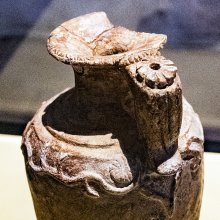Soya, Sōya: 7 definitions
Introduction:
Soya means something in Hinduism, Sanskrit, Marathi, Hindi, biology. If you want to know the exact meaning, history, etymology or English translation of this term then check out the descriptions on this page. Add your comment or reference to a book if you want to contribute to this summary article.
Images (photo gallery)
(+1 more images available)
In Hinduism
Ayurveda (science of life)
Source: Advances in Zoology and Botany: Indigenous Knowledge of Some Medicinal Plants of Himalaya RegionSoya refers to the medicinal plant “Anethum graveolens L.” from the Apiaceae family, and is used for ethnomedicine treatment of Fever in Ahmednagar district, India. The parts used are: “Fruit”. Instructions for using the plant named Soya: Leaves are cooked as vegetable and also used as flavouring in salads. Powdered fruit is given in cough, asthma, fever, ulcer and skin allergies.

Āyurveda (आयुर्वेद, ayurveda) is a branch of Indian science dealing with medicine, herbalism, taxology, anatomy, surgery, alchemy and related topics. Traditional practice of Āyurveda in ancient India dates back to at least the first millenium BC. Literature is commonly written in Sanskrit using various poetic metres.
Biology (plants and animals)
Source: Wisdom Library: Local Names of Plants and DrugsSoya [सोया] in the Hindi language is the name of a plant identified with Anethum graveolens L. from the Apiaceae (Carrot) family. For the possible medicinal usage of soya, you can check this page for potential sources and references, although be aware that any some or none of the side-effects may not be mentioned here, wether they be harmful or beneficial to health.
Source: Google Books: CRC World Dictionary (Regional names)1) Soya in English is the name of a plant defined with Glycine max in various botanical sources. This page contains potential references in Ayurveda, modern medicine, and other folk traditions or local practices It has the synonym Soja hispida Moench (among others).
2) Soya in India is also identified with Anethum graveolens It has the synonym Peucedanum sowa (Roxburgh) Kurz (etc.).
3) Soya in Senegal is also identified with Andropogon gayanus It has the synonym Cymbachne guineensis (Schumach.) Roberty (etc.).
Example references for further research on medicinal uses or toxicity (see latin names for full list):
· Soybean Sci. (1999)
· American Journal of Botany
· Pakistan Journal of Botany (1982)
· Acta Facultatis Rerum Naturalium Universitatis Comenianae, Botanica (1978)
· Monographiae Phanerogamarum (1889)
· Journal of Wuhan Botanical Research (1998)
If you are looking for specific details regarding Soya, for example side effects, chemical composition, health benefits, pregnancy safety, extract dosage, diet and recipes, have a look at these references.

This sections includes definitions from the five kingdoms of living things: Animals, Plants, Fungi, Protists and Monera. It will include both the official binomial nomenclature (scientific names usually in Latin) as well as regional spellings and variants.
Languages of India and abroad
Marathi-English dictionary
Source: DDSA: The Molesworth Marathi and English Dictionarysōya (सोय).—&c. See sōī &c.
Source: DDSA: The Aryabhusan school dictionary, Marathi-Englishsōya (सोय).—See sōī.
Marathi is an Indo-European language having over 70 million native speakers people in (predominantly) Maharashtra India. Marathi, like many other Indo-Aryan languages, evolved from early forms of Prakrit, which itself is a subset of Sanskrit, one of the most ancient languages of the world.
Hindi dictionary
Source: DDSA: A practical Hindi-English dictionarySoyā (सोया):—(nm) a sweet smelling plant used for preparing a vegetable; (a) slept; [soye śera ko śikāra nahīṃ milatā] a closed mouth catches no flies.
...
Kannada-English dictionary
Source: Alar: Kannada-English corpusSoya (ಸೊಯ):—[adjective] competent; capable; fit.
--- OR ---
Soya (ಸೊಯ):—
1) [noun] (correctly, ಸ್ವಯ [svaya]) 1. the state of being under another’s domination or the state of having another under one’s domination; subjection; subordination.
2) [noun] the state of being one with another; absorption.
3) [noun] that which is eternal.
4) [noun] something that belongs to oneself; belongings; possessions.
5) [noun] the quality or state of being true; truth; genuineness; honesty.
6) [noun] trust; confidence.
--- OR ---
Sōya (ಸೋಯ):—[adjective] competent; capable; fit.
--- OR ---
Sōya (ಸೋಯ):—
1) [noun] (correctly, ಸ್ವಯ [svaya]) 1. the state of being under another’s domination or the state of having another under one’s domination; subjection; subordination.
2) [noun] the state of being one with another; absorption.
3) [noun] that which is eternal.
4) [noun] something that belongs to oneself; belongings; possessions.
5) [noun] the quality or state of being true; truth; genuineness; honesty.
6) [noun] trust; confidence.
Kannada is a Dravidian language (as opposed to the Indo-European language family) mainly spoken in the southwestern region of India.
See also (Relevant definitions)
Starts with (+4): Coyam, Coyampu, Soya bean, Soyabean, Soyabin, Soyabina, Soyagedu, Soyah, Soyakara, Soyam, Soyama, Soyambara, Soyambarasale, Soyamdappu, Soyamvara, Soyara, Soyaradhayara, Soyaragata, Soyari, Soyarika.
Ends with: Anusoya, Anusoya, Asoya, Asoya, Asoya, Asoya, Jasoya, Khandashoya, Ksoya, Samsoya, Tukhm soya, Wild soya, Yaga bisoya.
Full-text: Tukhm soya, Soya bean, Bhatamasa, Wild soya, Hatavati, Ratanem.
Relevant text
Search found 2 books and stories containing Soya, Sōya, Soyā; (plurals include: Soyas, Sōyas, Soyās). You can also click to the full overview containing English textual excerpts. Below are direct links for the most relevant articles:
The Recipe < [October-December 1942]
Impressions of an American Tour < [October 1960]
International Affairs: A Monthly Survey < [March 1948]
The Bhikkhus Rules (by Bhikkhu Ariyesako)
Meal Time < [Chapter 3 - Possessions And Offerings]
Related products
(+7 more products available)











